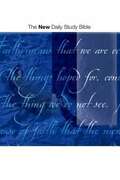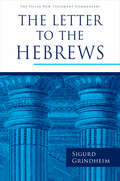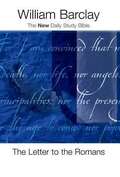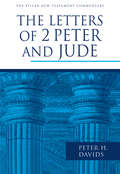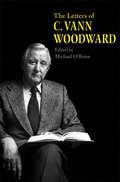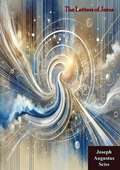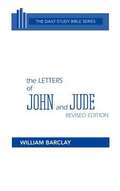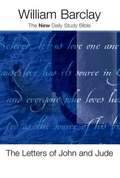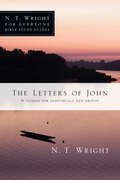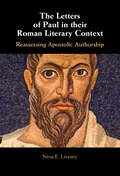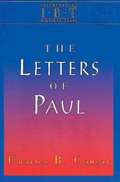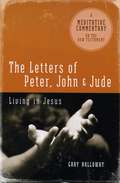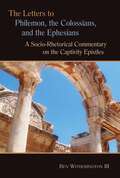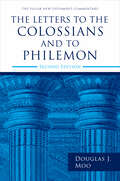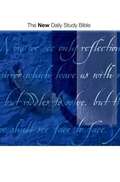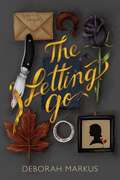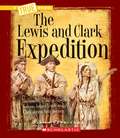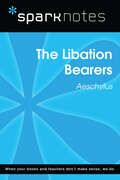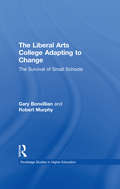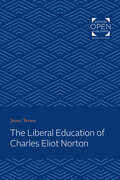- Table View
- List View
The Letter to the Hebrews
by William BarclayAt first glance, the letter to the Hebrews can seem difficult to comprehend, but William Barclay believed "that no New Testament book gives us such a glorious picture of Jesus Christ in all the splendor of his manhood and in all the majesty of his deity. " So, amplified by Barclay's keen and vibrant commentary, this ancient letter emerges from apparent obscurity to be a vital resource of encouragement for Christians today. For almost fifty years and for millions of readers, the Daily Study Bible commentaries have been the ideal help for both devotional and serious Bible study. Now, with the release of the New Daily Study Bible, a new generation will appreciate the wisdom of William Barclay. With clarification of less familiar illustrations and inclusion of more contemporary language, the New Daily Study Bible will continue to help individuals and groups discover what the message of the New Testament really means for their lives.
The Letter to the Hebrews (The Pillar New Testament Commentary (PNTC))
by Sigurd GrindheimWhat does the Letter to the Hebrews have to say to Christians today?A compelling exhortation to hold true to the faith in the face of adversity. A sermon rife with iconic imagery and Old Testament allusions. A signal work of theology in the New Testament.Above all, the Letter to the Hebrews proclaims the high priesthood of Jesus Christ. But the book&’s textual complexity and long history of interpretation can be overwhelming. In this new Pillar commentary, Sigurd Grindheim illuminates the Letter to the Hebrews, paying careful attention to linguistic features and historical context—all while centering its relevance to modern readers.Grindheim clearly and comprehensively addresses major issues about the text, including authorship, date, canonicity, formal qualities, and major themes. Following his thorough introduction, he explains each line of the text and its significance for believers today. Grindheim&’s commentary offers pastors, students, and scholars the clarity and fresh insights they want in their scriptural study.
The Letter to the Philippians (The Pillar New Testament Commentary (PNTC))
by G. Walter HansenIn this commentary G. Walter Hansen offers rich exposition of the text of Philippians as well as wisdom and maturity in its application. In so doing he emphasizes partnership--the social and corporate dimensions of community--in the progress of the gospel. After a select bibliography, Hansen's introduction sets forth the historical setting of the church in Philippi, the nature and occasion of the letter, and a preview of two key themes--the gospel of Christ and the community in Christ. The commentary itself discusses Philippians in light of these themes, considering Paul's greetings, reports of gospel ministry, imperatives for citizens worthy of the gospel, recommendations of two Christ-like servants, and disclosures of his personal experience. Hansen's treatment as a whole is distinctive for the way it draws out and highlights the themes of partnership, citizenship, and friendship in Paul's Philippian letter. "With themes and emotions so varied, the letter to the Philippians needs a commentator with a sure grasp and a warm heart. . . . Hansen writes with admirable clarity and simplicity, even when he is unpacking notoriously complex matters." -- D. A. Carson (from the preface)
The Letter to the Romans (The Bible in Medieval Tradition (BMT))
by Ian Christopher Levy Philip Krey Thomas F. RyanThis is the second volume of The Bible in Medieval Tradition (BMT), a series that aims to reconnect the church with part of its rich history of biblical interpretation.Ian Levy, Philip Krey, and Thomas Ryan's Letter to the Romans presents the history of early and medieval interpretations of Romans and gives substantial translations of select medieval commentaries. Written by eight representative medieval interpreters between the ninth and fourteenth centuries, these commentaries have never been translated into English before.This valuable book will enhance contemporary reading of the Bible even as it lends insight into medieval scholarship. As Levy says, the medieval commentaries exhibit "qualities that many modern commentaries lack: a spiritual depth that reflects their very purpose, namely, to read Holy Scripture within the sacred tradition under the guidance of the Holy Spirit."
The Letter to the Romans: A Short Commentary
by Frederick Dale BrunerIn the wake of his widely appreciated commentaries on the Gospel of Matthew and the Gospel of John, noted theologian and exegete Frederick Dale Bruner turns his attention to Paul&’s letter to the Romans. In this concise commentary, he relays his findings on what he calls the &“Fifth Gospel&” and its central claim that &“through the Father&’s love, Jesus&’s passion, and the Spirit&’s application of this passionate love, human beings can have a perfectly right relationship with God—by simple faith in His Christ.&” As he did in his commentaries on Matthew and John, Bruner engages historical interpreters from the patristic period to the present—including Augustine, Chrysostom, Aquinas, Luther, and Calvin—while also offering his own lucid translation of the text and relevant pastoral applications. The result is a holistic understanding of the book of Romans informed not only by one scholar&’s lifetime of ministry, teaching, and learning, but also by the full depth and breadth of church tradition.
The Letter to the Romans: The New Daily Study Bible
by William BarclayNOW IN AN ENLARGED PRINT EDITION! In ways that no other writing of the New Testament has achieved, the ideas expressed in the letter to the Romans have shaped formatively the whole of Christian belief. William Barclay's fresh translation and clear exposition allows readers the chance to see the heart of Paul's gospel. For almost fifty years and for millions of readers, the Daily Study Bible commentaries have been the ideal help for both devotional and serious Bible study. Now, with the release of the New Daily Study Bible, a new generation will appreciate the wisdom of William Barclay. With clarification of less familiar illustrations and inclusion of more contemporary language, the New Daily Study Bible will continue to help individuals and groups discover what the message of the New Testament really means for their lives.
The Letters of 2 Peter and Jude (The Pillar New Testament Commentary (PNTC))
by Peter H. DavidsFilling a notable gap in scholarship on 2 Peter and Jude, Peter Davids artfully unpacks these two neglected but fascinating epistles that deal with the confrontation between the Greco-Roman world and the burgeoning first-century Jesus communities. Davids firmly grasps the overall structure of these oft-maligned epistles and presents a strong case for 2 Peter and Jude as coherent, consistent documents. Marked by exceptional exegesis and sharp, independent judgments, Davids's work both connects with the latest scholarship and transforms scholarly insights into helpful conclusions benefiting Christian believers.
The Letters of C. Vann Woodward
by C. Vann Woodward Michael O'BrienC. Vann Woodward was one of the most prominent and respected American historians of the twentieth century. He was also a very gifted and frequent writer of letters, from his earliest days as a young student in Arkansas and Georgia to his later days at Yale when he became one of the arbiters of American intellectual culture. For the first time, his sprightly, wry, sympathetic, and often funny letters are published, including those he wrote to figures as diverse as John Kennedy, David Riesman, Richard Hofstadter, and Robert Penn Warren. The letters shed new light not only on Woodward himself, but on what it meant to be an American radical and public intellectual, as well as on the complex politics and discourse of the historical profession and the anxious modulations of Southern culture.
The Letters of Jesus
by Joseph Augustus SeissThe Letters of Jesus by Joseph Augustus Seiss is a profound and insightful exploration of the seven letters addressed to the churches in the Book of Revelation. Seiss, a distinguished theologian and scholar, delves into these messages from Christ to the early Christian communities, offering readers a deep understanding of their spiritual significance and timeless relevance.In this illuminating work, Seiss carefully analyzes each of the seven letters found in Revelation chapters 2 and 3, uncovering the rich symbolism, theological depth, and practical guidance contained within Christ’s words. He explores the historical context of the letters, the specific challenges faced by the early churches, and the spiritual lessons that these letters impart to believers today.Seiss' exposition is both scholarly and devotional, blending rigorous biblical interpretation with heartfelt spiritual application. He highlights how these letters, though written to specific churches in the first century, convey universal truths about faith, perseverance, repentance, and the nature of true Christian discipleship. Each letter is examined in detail, revealing the encouragement, rebuke, and promises that Jesus offers to His followers.The Letters of Jesus serves as a guide for individual believers and church communities alike, encouraging a deeper reflection on Christ’s words and a more faithful response to His call. Seiss’ writing is both accessible and profound, making this book suitable for both scholars and lay readers seeking to enrich their understanding of Scripture.This book is essential reading for anyone interested in the Book of Revelation, early Christian history, or the teachings of Jesus. The Letters of Jesus provides timeless wisdom for navigating the challenges of faith and offers a powerful reminder of Christ’s enduring presence and guidance for His Church.Joseph Augustus Seiss’ work continues to inspire and instruct, helping readers to connect with the divine messages that have shaped the Christian faith for centuries. Through The Letters of Jesus, believers are invited to hear afresh the voice of Christ calling them to a deeper, more committed walk with God.
The Letters of John and Jude (The Daily Study Bible Revised Edition)
by William BarclayCommentary on the three letters of John and the Letter of Jude.
The Letters of John and Jude: The New Daily Study Bible
by William BarclayNOW IN AN ENLARGED PRINT EDITION! The letters of John and Jude deal with heretical teachings within the early church. Here William Barclay uses his characteristically approachable writing style to offer fresh translations and compelling commentary on these texts. For almost fifty years and for millions of readers, the Daily Study Bible commentaries have been the ideal help for both devotional and serious Bible study. Now, with the release of the New Daily Study Bible, a new generation will appreciate the wisdom of William Barclay. With clarification of less familiar illustrations and inclusion of more contemporary language, the New Daily Study Bible will continue to help individuals and groups discover what the message of the New Testament really means for their lives.
The Letters of John: 9 Studies For Individuals Or Groups (N. T. Wright for Everyone Bible Study Guides)
by N. T. WrightIn his letters, John expresses delight at believers who are "walking in the truth": behaving with that integrity which reflects the gospel. This involves not just correct doctrine and proper outward behavior, but also love for God and fellow believers. It's this love, John writes, that shows that the truth of the gospel has really been grasped, not as an abstract idea but as what it is, the very life of God himself at work in his people. These nine studies from Tom Wright help us become believers who are "walking in the truth" in our own day--people in whom the very life of God is at work for all to see.
The Letters of Paul in their Roman Literary Context: Reassessing Apostolic Authorship
by Nina E. LiveseySince the late-nineteenth century, scholars have all but concluded that the Apostle Paul authored six authentic community letters (Romans, 1 and 2 Corinthians, Galatians, Philippians, and 1 Thessalonian) and one individual letter to Philemon. In this book, by contrast, Nina E. Livesey argues that this long-held interpretation has been inadequately substantiated and theorized. In her groundbreaking study, Livesey reassesses the authentic perspective and, based on her research, reclassifies the letters as pseudonymous and letters-in-form-only. Like Seneca with his Moral Epistles, authors of Pauline letters extensively exploited the letter genre for its many rhetorical benefits to promote disciplinary teachings. Based on the types of issues addressed and the earliest known evidence of a collection, Livesey dates the letters' emergence to the mid-second century and the Roman school of Marcion. Her study significantly revises the understanding of Christian letters and conceptions of early Christianity, as it likewise reflects the benefit of cross-disciplinarity.
The Letters of Paul: Interpreting Biblical Texts Series (Interpreting Biblical Texts)
by Charles B. CousarThe Interpreting Biblical Texts series presents a concise edition covering the seven undisputed epistles of Paul. In this volume, Charles Cousar is primarily concerned not with the man Paul and his life and work, but with his surviving letters. Part 1 introduces methods in reading the Pauline letters. Part 2 attends to the critical themes emerging in the letters--the decisiveness of Jesus Christ and old versus new life. Part 3 discusses the other six letters bearing Paul's name that appear in the New Testament.
The Letters of Peter, John & Jude: Living in Jesus
by Gary HollowayA study of the shorter and sometimes neglected letters of the New Testament -- 1 & 2 Peter, 1, 2 & 3 John and Jude. As you study these letters you will be called to imitate the sacrificial life of Jesus while focusing on faith. The meditative style of "holy reading" makes the text more memorable and applicable to our lives. The Bible is not just an ancient book to study but a living window into the very life of Jesus. One way we encounter the living Jesus in the Bible is through the time-tested method of "holy reading" or meditation. This commentary series provides a structure for that encounter with Jesus. Holy reading involves listening closely to a brief passage of Scripture, reading it repeatedly, praying the words, letting them sink deeply into the heart. It can also be a communal exerience as we listen to God with other believers. Through meditation on these wonderful little letters, we experience the blessings of living for Jesus.
The Letters to Philemon, the Colossians, and the Ephesians: A Socio-Rhetorical Commentary on the Captivity Epistles
by Ben Witherington IIIThis volume completes Ben Witherington's contributions to the set of Eerdmans socio-rhetorical commentaries on the New Testament. In addition to the usual features of these commentaries, Witherington offers an innovative way of looking at Colossians, Ephesians, and Philemon as interrelated documents written at different levels of moral discourse. Colossians is first-order moral discourse (the opening gambit), Ephesians is second-order moral discourse (what one says after the opening salvo to the same audience), and Philemon is third-order moral discourse (what one says to a personal friend or intimate). Witherington successfully analyzes these documents as examples of Asiatic rhetoric, explaining the differences in style from earlier Pauline documents. He further shows that Paul is deliberately engaging in the transformation of existing social institutions. As always, Witherington's work is scholarly and engaging. With detailed "Closer Look" sections, The Letters to Philemon, the Colossians, and the Ephesians is perfect for the libraries of clergy, biblical scholars, and seminaries.
The Letters to the Colossians and to Philemon, 2nd ed. (The Pillar New Testament Commentary (PNTC))
by Douglas J. MooAn erudite and evangelical guide to Paul&’s letters to the Colossians and to Philemon With brilliant exegesis and sound practical insight, noted commentator Douglas J. Moo explicates the Letters to the Colossians and to Philemon, with an eye toward their application for readers today. Moo bases his commentary on the Greek text of the letters, while accessibly explaining the English text to his contemporary audience. Freshly revised and updated, this second edition remains methodologically sound, authentically evangelical, and pastoral in approach. This invaluable volume of the Pillar New Testament Commentary series offers biblical insights to a wide range of readers, from teachers and students to pastors and parishioners.
The Letters to the Corinthians
by William BarclayCorinth was not only one of the most flourishing commercial centers of the ancient world, but also a symbol of vile debauchery. "In this hotbed of vice," writes William Barclay, "some of the greatest work of Paul was done. " In his endearing, simple, and illustrative manner, Barclay shows how the message that Paul communicated to the Corinthians continues to help us who live today in the midst of twenty-first century temptations. For almost fifty years and for millions of readers, the Daily Study Bible commentaries have been the ideal help for both devotional and serious Bible study. Now, with the release of the New Daily Study Bible, a new generation will appreciate the wisdom of William Barclay. With clarification of less familiar illustrations and inclusion of more contemporary language, the New Daily Study Bible will continue to help individuals and groups discover what the message of the New Testament really means for their lives.
The Letters to the Galatians and Ephesians
by William BarclayIn his letter to the Galatians, Paul explains his need to understand that the grace of God is offered for all people - whoever they are and whatever their background. William Barclay's commentary takes us through the letter and helps us to unpeel the inspiring layers of meaning in the description of the quality of grace. In the letter to the Ephesians, the nature of the tension between good and evil is explored and Christians are encouraged to put aside harmful self-interest and live together in unity.
The Letting Go
by Deborah MarkusEveryone Emily has ever loved has been brutally murdered. The killer has never been caught, but Emily knows who’s responsible.She is. It’s the only possible explanation. Emily is the one thing all the victims have in common, which can only mean that someone—or something—is killing them to make her suffer. Determined never to subject another person to the same horrible fate as her parents, friends, and pets, Emily sequesters herself at a private boarding school, keeping her classmates at a distance with well-timed insults and an unapproachable air. Day after day, she loses herself in the writing of Emily Dickinson—the poet makes a perfect friend, since she’s already dead. Emily’s life is lonely, but it’s finally peaceful. That is, until two things happen. A corpse appears on the steps of the school. And a new girl insists on getting close to Emily—unknowingly setting herself up to become the killer’s next victim.
The Lewis And Clark Expedition (True Books: Westward Expansion)
by John PerritanoComprehensive text about the Lewis and Clark expedition in the Louisiana territory in preparation for the Louisiana Purchase.
The Libation Bearers (SparkNotes Literature Guide Series)
by SparkNotesThe Libation Bearers (SparkNotes Literature Guide) by Aeschylus Making the reading experience fun! Created by Harvard students for students everywhere, SparkNotes is a new breed of study guide: smarter, better, faster. Geared to what today's students need to know, SparkNotes provides: *Chapter-by-chapter analysis *Explanations of key themes, motifs, and symbols *A review quiz and essay topicsLively and accessible, these guides are perfect for late-night studying and writing papers
The Liberal Arts College Adapting to Change: The Survival of Small Schools (RoutledgeFalmer Studies in Higher Education #Vol. 09)
by Robert Murphy Gary BonvillianFirst Published in 1996. Routledge is an imprint of Taylor & Francis, an informa company.
The Liberal Arts Paradox in Higher Education: Negotiating Inclusion and Prestige
by Kathryn TellingThe liberal arts approach to higher education is a growing trend globally. We are told that the mental dexterity and independent, questioning spirit cultivated by such interdisciplinary degrees are the best preparation for the as-yet unknown executive jobs of tomorrow. This book explores the significant recent growth of these degrees in England in order to address an enduring problem for higher education: the relationship between meritocracy and elitism. Against the view that the former is a myth providing rhetorical cover for the latter, it argues that these are two entangled, but discrete, value systems. Sociology must now pay attention to how students and academics attempt to disentangle them.
The Liberal Education of Charles Eliot Norton
by James C. TurnerOriginally published in 1999. James Turner's biography offers the first modern account of Norton's life and its significance, following him from his perilous travels across India as a young merchant to his role as his country's preeminent cultural critic. Turner shows how Norton developed the key ideas that still underlie the humanities—historicism and culture—and how his influence endures in America's colleges and universities because of institutions he developed and models he devised.
